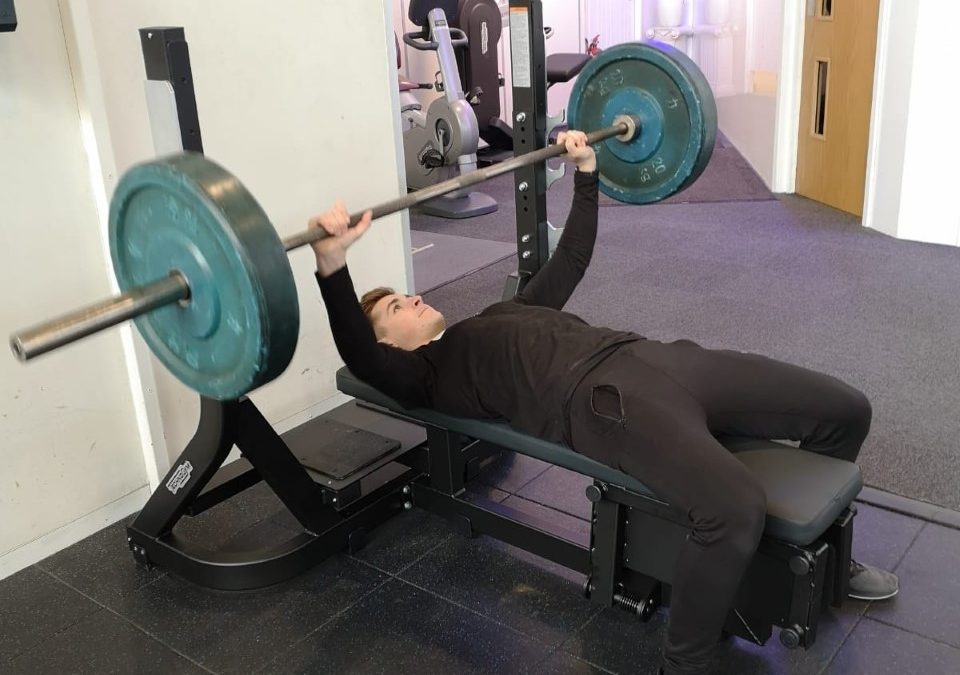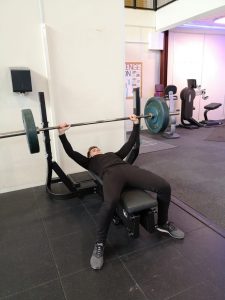Have you seen our new top of the range Technogym bench?
The bench press is a compound movement that targets the main pushing muscles in the upper body – the chest being a primary mover, with the shoulders and triceps as secondary movers.
As you are recruiting force from a group of strong muscles across more than one joint, you will be able to use a significant amount of weight on the bench press. This makes it ideal for overloading muscles with the stress required for increased muscle growth and strength.
The weight you use on a bench press will be much more than chest isolation movements such as cable flys, meaning it will have the most significant impact on your central nervous system (CNS). This is good for us, as CNS adaptation will create a quick response to the new stimulus, leading to fast improvements in strength output.
How to perform the bench press
It is important to use correct form when performing the bench press in order to prevent injury under heavy loads, and to ensure that you’re activating the chest muscles properly rather than letting your shoulders take over.
The first step is to lay flat on the bench with your eyes directly under the bar. You need to make sure that your feet are firmly planted and that you have three points of contact with the bench; your glutes, upper back, and the back of your head.
Next you will want to pull your shoulder blades back, then down, and squeeze them together. This will keep your shoulders in a safe position throughout the movement and prevent them from taking over the movement.
Then you need to grip the bar evenly at a grip width which feels comfortable for you. I would recommend starting with your ring finger over the ring on the gnarling, and then adjust as needed.
Once you have this position you are ready to lift the bar out from the rack position, and then slowly lower it to the bottom of your chest. Pause the bar roughly an inch away from your chest and then press it back to full extension of the arm.
Repeat this at a tempo of 2 seconds down and 2 seconds up for the desired amount of reps.
EXERCISE VARIATIONS
Close Grip Bench Press
The close grip bench press is a great way of turning the bench press into a more triceps dominant movement.
All the pushing muscles will still be engaged however the narrower grip will increase the range of motion and emphasise triceps activation within the movement.
Because of the triceps emphasis, performing the close grip bench press is a great way of getting stronger on the lock out portion of the rep, so is a good way to overcome a strength plateau.
To perform this variation, set up the same as you would with the conventional bench press but with a closer hand grip. I would recommend starting with your little finger just inside of the gnarling ring, then adjust as needed.
Paused Bench
The paused bench press is a great way to improve your strength on the bottom portion of the rep and increase chest activation within the movement. This paired with a close grip bench press is perfect for overcoming a strength plateau.
To perform the paused bench press, complete the movement the same as you normally would, however, you will pause the bar when it reaches 1 inch above your chest and hold it for anywhere between 1 and 3 seconds, then press back up.
This increases time under tension, helps to activate the chest more throughout the movement, and eliminates momentum to encourage control over the rep.
Tempo Bench
Tempo bench press is a variation ideal for getting more control and confidence with the movement while also increasing time under tension to encourage muscle growth without having to use a massive amount of weight.
To perform the tempo bench press you will complete the movement as you normally would, however, you need to control the bar to move at a certain speed.
Lowering the bar should take 4 full seconds, then without pausing at the bottom you then push the bar back at the count of another 4 seconds, meaning each full rep takes 8 seconds to complete.
Bench Press 21s
Bench press 21s are a great way to increase volume on the bench press and discover where your weak spots are in the movement.
To perform this variation, you will complete 21 total reps in each set. The first 7 reps will just be the bottom part of the movement, moving the bar from your chest to halfway up. The next 7 will be the top portion moving the bar from halfway to full extension of the arms, and the final 7 reps will be the full movement.
This is not only very challenging, but it will reveal if you’re weakest at the bottom or top range of motion, which can then allow you to know if you should focus on either paused bench or close grip bench in order to overcome a plateau.
1.5 Reps
1.5 reps are the final bench press variation and are again a great way to increase overall volume, time under tension, and increase chest activation within the movement.
To perform 1.5 reps, you will do the bench press as you normally would until the bar reaches your chest. At this point you will lift the bar halfway up, then go back down to your chest, and then finishing the rep by pushing the bar all the way back up. This is one completed 1.5 rep.
This will put more tension on the chest at the lengthened position allowing for more of a stretch on the muscle which can be very useful for building a better mind-to-muscle connection if this is something you struggle with.
See tfd’s Ash below demonstrating a bench press… If you would like any help using the new bench press or with workout ideas, don’t hesitate to grab one of our instructors or book in an appointment to see one of them!
by Ash – Level 3 Personal Trainer


